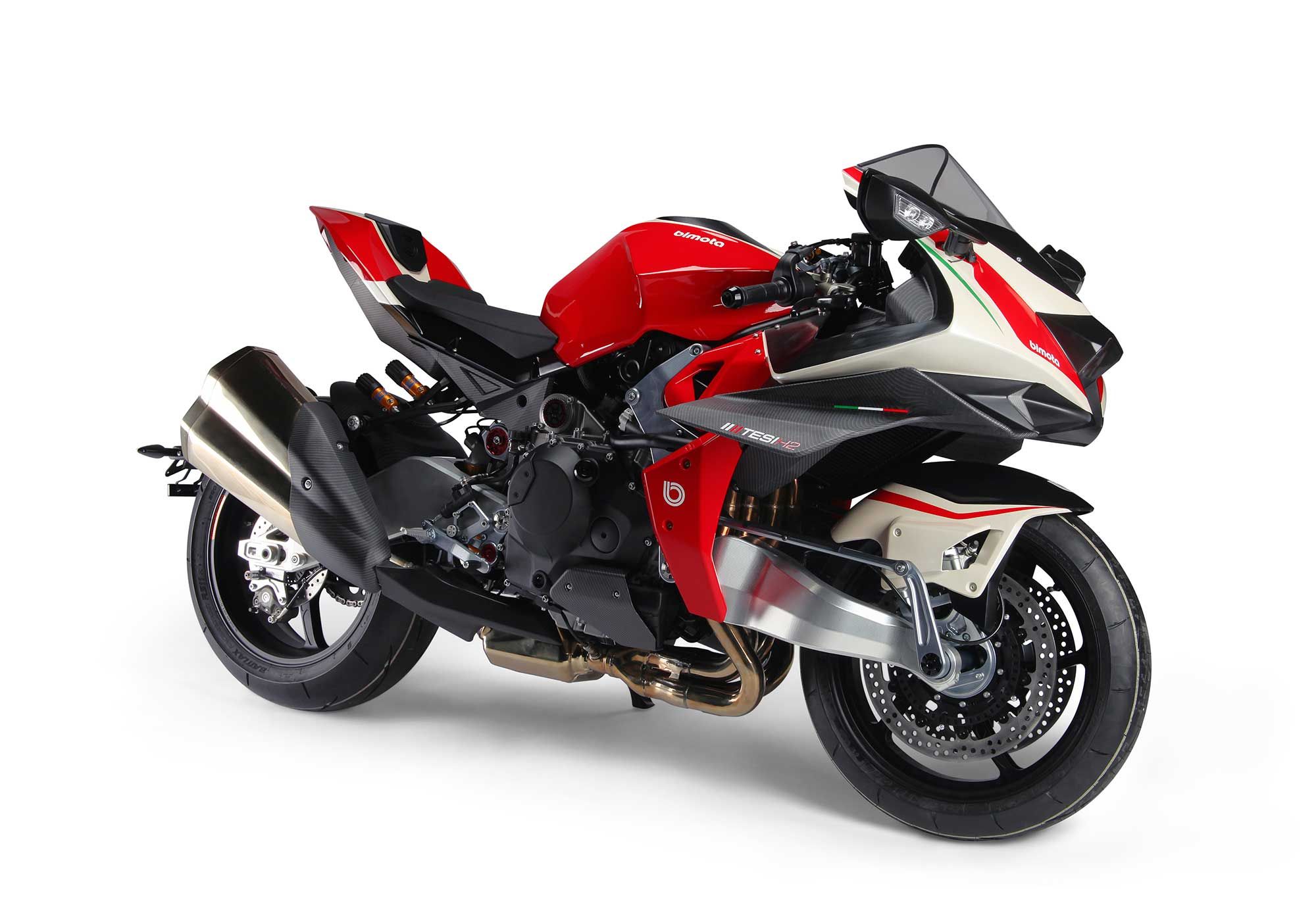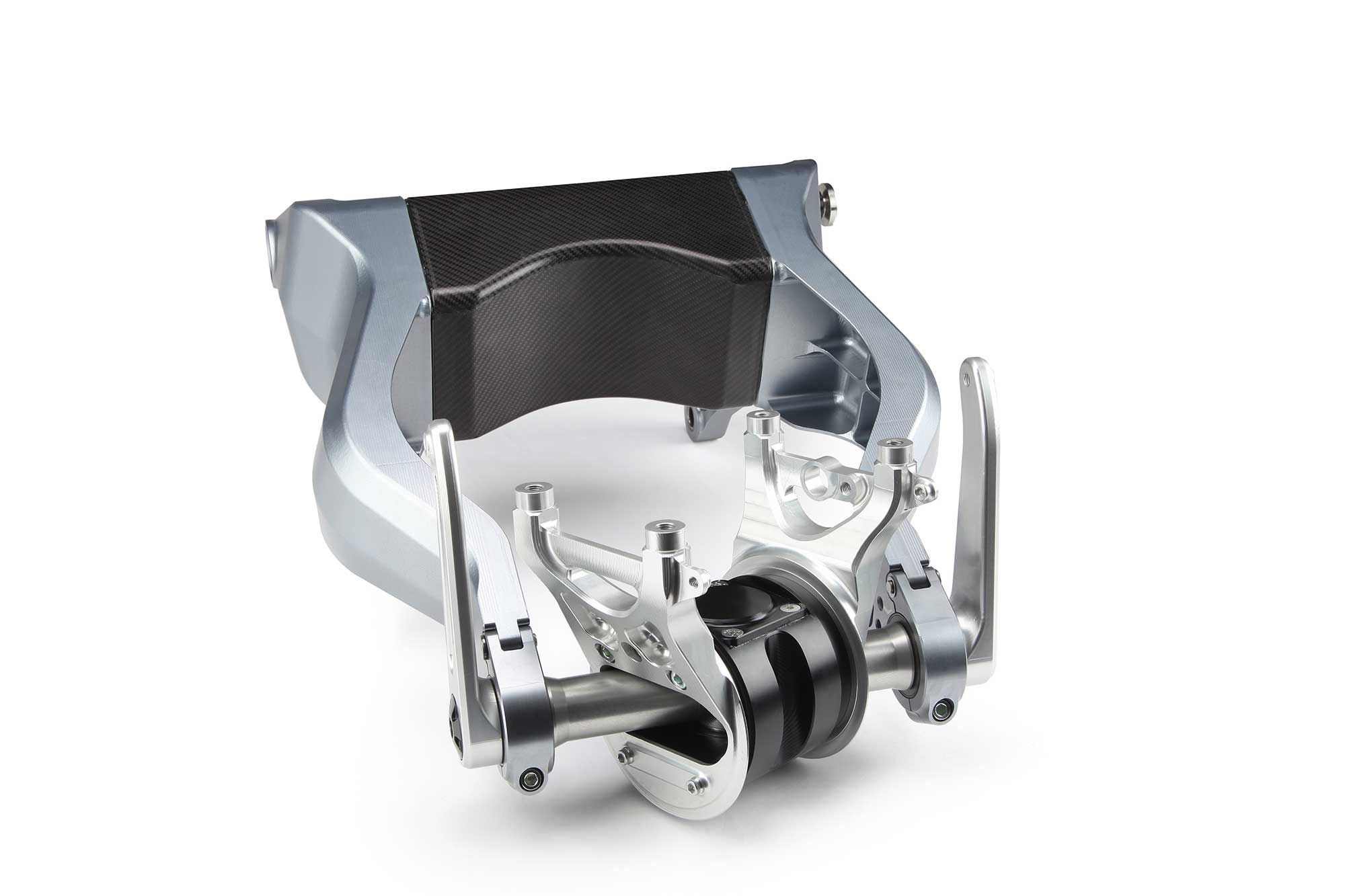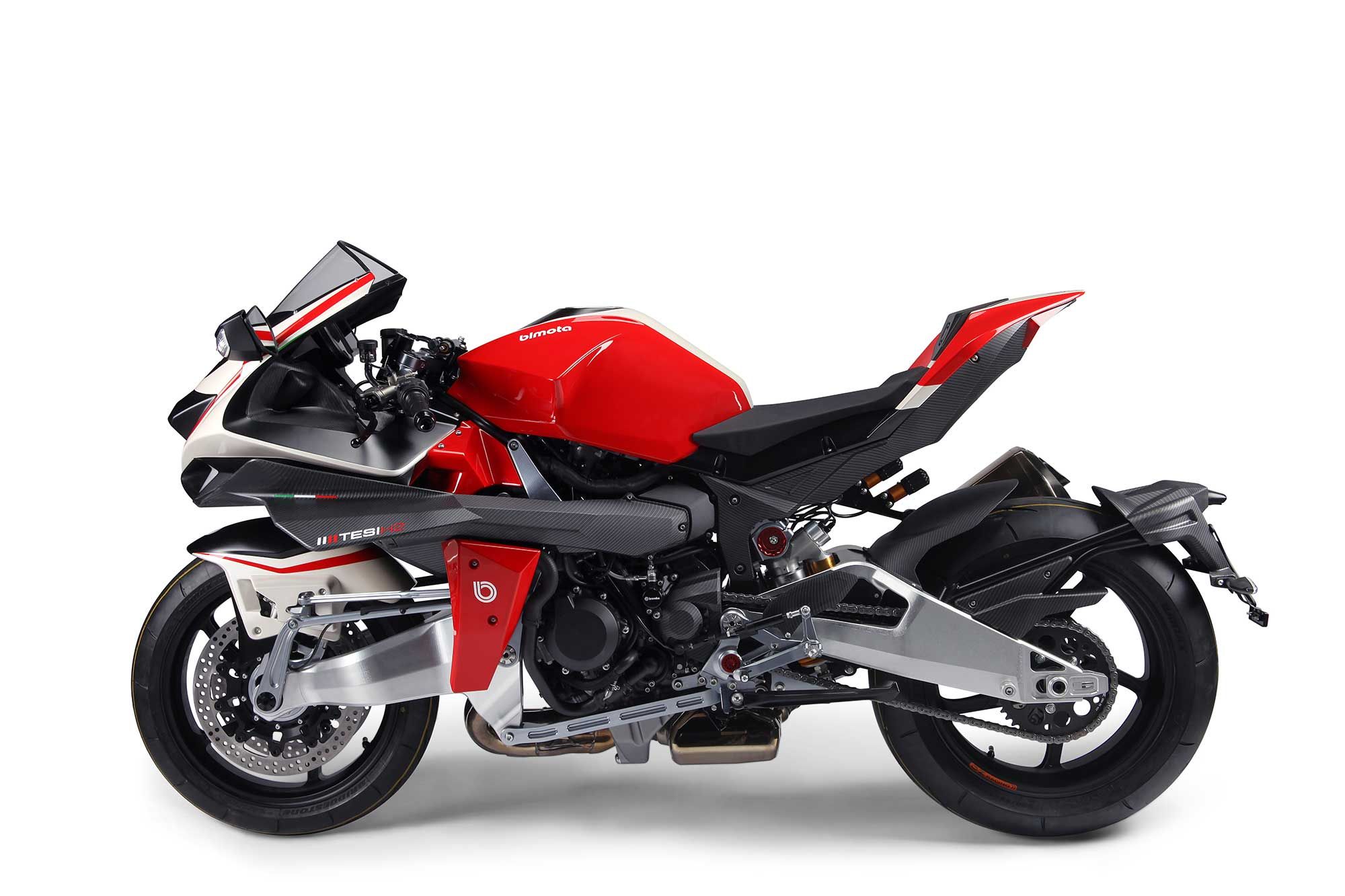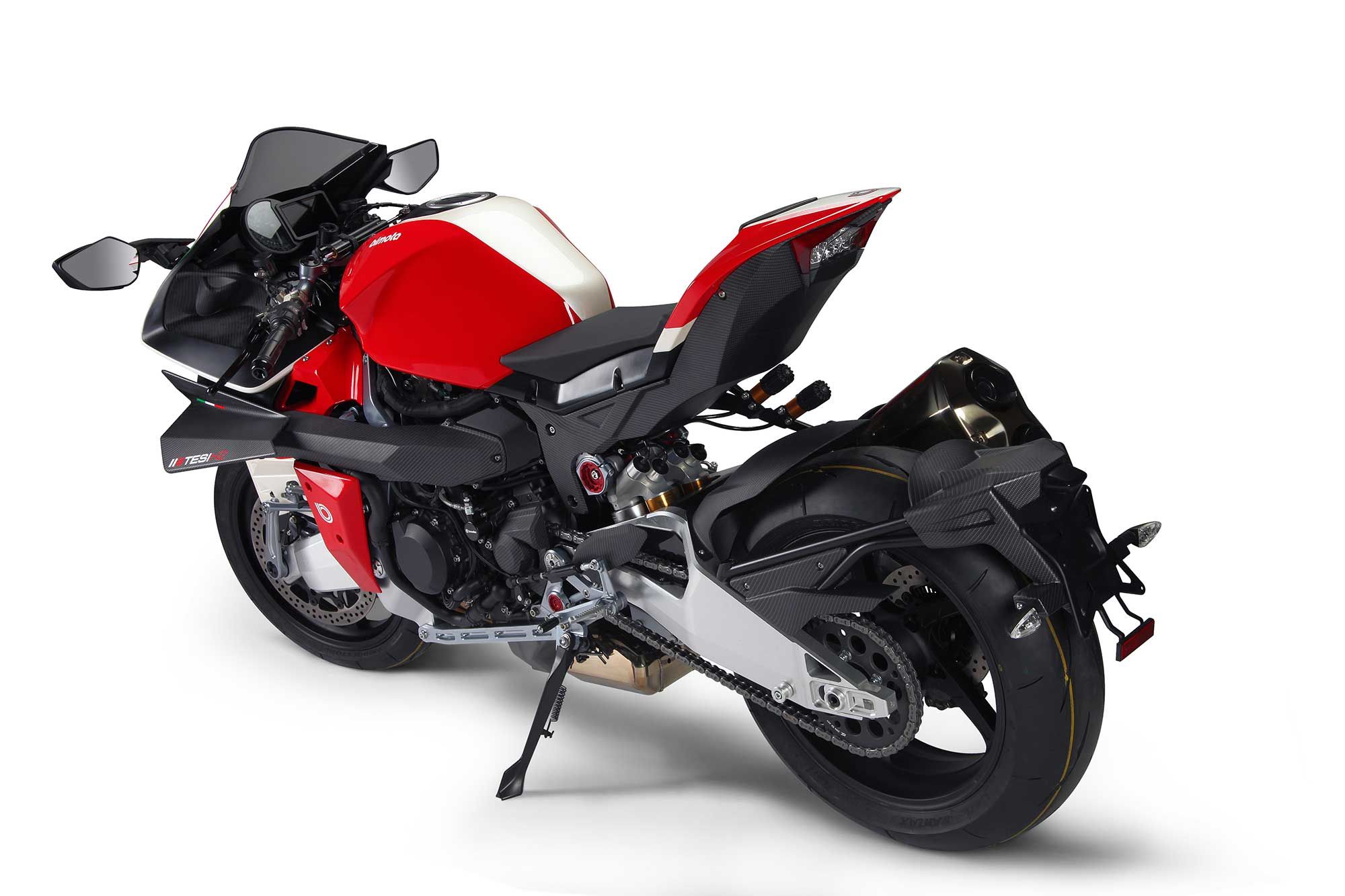
When we told our readers last year that Kawasaki had acquired 49% of Bimota, and was in the process of developing a new Tesi H2 with hub-center steering and an off-the-shelf (no bad thing, in this instance) supercharged Kawasaki engine, there was a back-story our younger readers undoubtedly missed.
Motorcycle enthusiasts of a certain age (including … ahem, yours truly) remember Bimota as the wild child of motorcycle manufacturing, known for outrageous designs and engineering. The stunning CNC-machined billet parts, motor tuning and chassis lightening that turned production motorcycles into exotic superbikes.

Of course, time caught up with Bimota and production superbikes became too light, powerful and trick for a small concern like Bimota to significantly enhance. The role Bimota played in the industry ended. Enter Kawasaki.
Is Kawasaki the wild child among modern motorcycle manufacturers? Who dared out-Hayabusa the Hayabusa with a ZX-14? Who put a supercharged 1,000cc inline-four into mass production and sold it to the public … without including a parachute? Well, that would be Kawasaki.

So this modern Kawasaki/Bimota relationship makes sense, in a way. With the combination of the most outrageous (again, not in a bad sense) engineering development of the Bimota brand, the hub-steering Tesi, with the equally outrageous Kawasaki supercharged powerplant from the H2, we now have a production motorcycle with final photos, specifications, and even pricing.
You can see production specifications for the Bimoto Tesi H2 here. 250 units are available for pre-order at roughly $75,000 U.S. (€64,000). For that, you get a rolling piece of art, that apparently rolls quite well.
231 horsepower and 104 pound/feet of torque motivate a claimed dry weight of 456 pounds. In addition to the unusual front end (the benefits of which are described quite well by Kevin Cameron), awesome Brembo brakes (including dual 330 mm front discs) are part of the package.

What do you think of this new Tesi? Did you drool over Bimota designs as a kid, just as I did? We’ll report on the performance of the new Bimota Tesi H2 once journalists get their hands on a production unit.






People don’t get it. This isn’t a bike for the mass market, this is for collectors, with more fun coupons than anyone can imagine. These bikes are going to be bought by people with collections to be dusted, not ridden. It is, after all, a beautiful machine. That is all I take away from it.
Nope!
Regardless of power output, I have no interest in an exotic super expensive bike that not only weighs over 400 pounds wet. This thing is actually closer to 500 pounds once you can throw a leg over and ride the thing. What is Kawasaki’s usual dry lie?
Then this is supposed to be an Italian motorcycle. No Italian designer worth his chianti would create such a forward heavy design. One that includes both the currently fashionable turbo ridiculous abbreviated tail section and the most hideous unsprung mess/disaster garbage collection wrapped around the rear tire to attempt to make up for it.
It’s sad to say. But Bimota made a deal with the devil and lost.
I’ll just go with the H2 SX SE thank you. I won’t even screw with it to get 230hp.
The Pushmi Pullyu of motorcycles.
Impressive engineering but no thanks. Not exactly pretty and as it says in the article, there’s really no justification anymore, as standard bikes have become so good.
Just revive the V-due but make it work this time.
US DOE’s Argonne National Laboratory has developed a computer model called GREET that you can feed all sorts of parameters into to see what happens. Wikipedia’s GREET entry is a good place to start exploring this at no cost. The model will even reveal what its name means.
What did it look like before the accident?
And they kept the ugliest part of the Kaw?
I just ordered three of these. But I told them they had to throw in floor mats and undercoating or no deal. Ha! They folded like a cardboard suitcase.
Yep, another super limited, super high cost, Bimota that some will probably sing it’s attributes. And in the end, a short time down the road, will meet again with the demise of this historic but always ungodly expensive brand.
$75K = Once nice Panigale V4 + one nice Harley (not a bagger) + Kawasaki H2 and still leave about $10k for a nice vacation…
I was the proud owner of one of the early Tesi’s, a peice of art and a good bike on the road, too. At that time there was a lot of talk about the end of time for conventional forks and I was one of the followers. Today we know better and if we look at contemporary MotoGP bikes, they basically still look very “conventional” from a suspension point of view.
So, of this new Bimota is the answer some decades later, I wonder what is the question this time…??
I’m also a fan of the unconventional. I really adore the telelever and duo-lever fronts of BMWs, having owned both. Pushing it, I’ve always had more confidence with them than on my telescopers like my current Z1000SX and H2 SX. Dive, at it’s extreme leads to pushing the front tire and the BMW never did that. And I’ve had some less accepted forks on my XC mountain bikes in years past like the AMP research parallelogram fork and a Girvin.
I believe the biggest reason you don’t see alternate front end designs in GP is that big changes like that can mean an expensive losing season of R&D. Right now, they’re all on the same type and they’re all competitive. One big change and the team will likely be at the back of the pack for a full season until the rider and team come to grips with it. These guys grew up with fork dive and would be resistant to learning how to feel something different. Sponsors would get scared and take their money back because their logo won’t be seen on TV anymore as the camera only focuses on the leaders and occasionally the mid pack.
Race tracks are also fairly flat. And smooth. The built in mechanical antidive of alternative front suspensions, really shine on steep downhills. As well as when riding fast, on a bike which also needs lots of travel for times when “roads” aren’t so smooth, such as the GS.
If I’m not mistaken, I believe technical rules prohibit anything but telescopic forks in racing.
I saw pre-order at roughly $75,000. No thanks.
If for me Biomota would move the decimal point to the left just one I would buy it.
Bimota Tesis were very exciting bikes to me. Unfortunately this bike is missing one of the main feature of the earlier models; light-weight design. Previous model had an air-cooled Ducati V2 for that reason.
I am glad they are going back to their roots with the inline-four. Bimota always chose the fastest engines to use, I always felt the later v-twins were a concession to style, not performance and that they sold out a little. I do miss the more hand crafted feel of the early bikes with fabricated tubular elements and a touch over the whole bike. This does look like they forgot about the rear half of the Ninja.
The V2 actually packaged better and made a lighter bike because the side plates that connected the front and rear swingarms bolted right to the case halves and the rider perch and everything else bolted to the top of those side plates. The design is very modular and easy to disassemble.
That type of design made it very easy to come in under 400 lbs fully wet. The Vyrus 987 with the Duc 1098 engine and a supercharger weighs 375 lbs with a full tank of gas.
That is true for several other Bimotas. Many cool KBs, YBs, SBs etc. They could have used the H2 engine in a superbike form for sure.
To me, the heritage of the Tesi in particular is light weight, compact design.
Motorhead agree with your comment. Change is always hard to accept. On Google “Conventional gasoline vehicles only convert about 17%–21% of the energy stored in gasoline to power at the wheels.” An electric motor typically is between 85% and 90% efficient”. On September 22nd Tesla will have a battery announcement. Rumor is that a breakthrough has been found producing a 50% higher battery charge density which translates to a longer range between recharging. We will see.
Never before have I heard motorcycle enthusiast be excited about efficiency. Efficient diesel motorcycles weren’t a thing, ever. Nobody knows or cares if the charged Kawasaki engine in this Bimota is more efficient (it should be) than a naturally aspired engine.
When Alta was still around and making electric motocross bikes people were excited about the possible performance gains. I never heard anybody talking of caring about energy efficiency. Range was an issue however, but that has more to do with battery capacity.
Besides your comparison of efficiency from gasoline in the tank to power at wheels versus electricity at motor to power at output shaft of the motor makes absolutely no sense.
First, naturally aspirated ICEs have been rated at an average of 27% efficient since the 90s. Even better now, possibly 30% at the rear wheels.
You forget that an ICE is it’s own power plant. So 30% is what it is for the sake of this discussion.
While an electric motor is 85-90% efficient working off electricity from a battery, you still have to factor in where that electricity comes from. How efficient is the power generation plant? I don’t know that number. How much is lost over miles and miles of transmission lines? Typically, 25-30% is lost in the form of electromagnetic radiation and resistance from plant to the transformer outside your house. So that leaves an EV at 55-60% efficient minus whatever the inefficiency of the plant is. Never mind how much that plant pollutes. In the end, it is probably a wash between the 2 types.
But my eye is on Tesla and their battery capacities. I’m even looking into their power Wall and solar shingles for my house. As I pay about 400-450/month to the electric company, I look forward to getting off the grid if the long term numbers work out. I would need 4 Power Wall batteries plus the shingles which adds up to around $40k installed. Over 25 years of warranted life, that works out to 1/3 of what it would cost to stay on the grid for 25 years not including rate increases.
Bob, understand your calculations. Installed solar panels on my roof 2 years ago. During the day sell my electricity to Idaho Power and during the night consume their electricity. Overall, I generate more electricity than consume and apply at the end of the year for a refund. Ten weeks ago ordered a Tesla Model S, long range model. Will be obviously charging the vehicle at home, if at all possible. Own a Kawasaki Ninja 400 and Versys 650. When electric motorcycles have a longer range will be in the market. Hoping this occurs in a few years. A very strong proponent of climate change with the fires along the West coast.
Harry, I’m still researching but doing it seriously. The 4 Power Wall batteries would give me a total of 20kW nominal power/28kW peak. In Houston the 4 ton A/C runs 52 weeks a year and I have a 50 amp swim spa that cycles constantly, not to mention 2 fridges and an upright freezer. God forbid I turn on the the guitar amp that pulls 600 watts out the wall. I may be over-estimating and only need 3 batteries instead of 4. I really wish I had a way to analyze what I’m really consuming when all of these items are running simultaneously plus the washer/dryer and a 2 stage air compressor. No EVs yet, I wouldn’t mind an Energica Ego. But like you, the plan is to sell some back and get a check. But I don’t want to overproduce. I just need enough overhead to cover my most extreme needs.
I may be over-estimating and only need 3 batteries instead of 4. I really wish I had a way to analyze what I’m really consuming when all of these items are running simultaneously plus the washer/dryer and a 2 stage air compressor. No EVs yet, I wouldn’t mind an Energica Ego. But like you, the plan is to sell some back and get a check. But I don’t want to overproduce. I just need enough overhead to cover my most extreme needs.
That. Plus electric vehicles also have transmission loses. Very few spin the wheels directly off the motor. These loses can be significant.
The electric motor has 85-90% efficiency but so does the voltage converter to the battery and the inverter to the motor. So that’s potentially a 30-40% loss of efficiency from the wall outlet to the motor. Add this on top of the efficiency loss in power transmission from the power plant and the losses in the car’s actual transmission and you’re potentially not much more efficient than a gasoline powered car. Diesel looks even better, if it wasn’t so dirty. And, yes, I work in the development of electric vehicles!
How much energy is spent/lost refining crude into gasoline? How much energy is spent in its storage/transportation/distribution?
That’s all rhetorical because it doesn’t matter. Whatever the efficiency of the various electricity production methods, the fact is that an electric car’s “fuel” is delivered to virtually ever room humans use and inhabit. The infrastructure is there and ready. Increased power demand from cars will only serve to improve power production’s efficiency. Those kinds of improvements aren’t coming for petroleum.
I really don’t think that 250, overpriced hub steering motorcycles will have any effect on the world of 2 wheels. Most likely still has a severely limited turn radius below mach 1.
Nice. But a bit late and a swan song. Any exciting motorcycle five years out will be electric.
Hmmmmm? Not sure I agree with that one.
Electric motorcycles are not at all exciting to me. Nor are they nearly as engaging to ride. I can see the popularity of internal combustion motorcycles spanning the next century, or at least until they are mandated out of existence.
Truth. The engagement is why I do it. I’d miss shifting gears and the sound of the engine telling my ears when to shift. power wheelies in multiple gears on an electric? There are no gears so there’s no lunge like there is with each shift.
Not sure what’s so exciting about drastically shorter range, for a type of vehicle which is already range challenged.
If battery fire risks can be brought under control: Noise and pollution free SuMo tracks in the likes of Central Park, or even indoors, would be pretty sweet, though.
But outside of specialized use cases like that, there are good reasons why consumers have largely decided that the battery powered two wheelers which make the most sense, are pedelecs (aside from Birds…..). Those things move slow enough that the downright atrocious aerodynamics of any upright, non-streamliner, bike, matters less. And also slow enough that they can use battery-range friendly bicycle components, compared to which even the lightest motorbike kit, is positively obese. (Rossi’s bike seems nice and responsive and light, until you pick up Roglic’s)
I agree with all the engagement and involvement with manual transmissions, but it sort of proves my point. We are old. We like shifting gears. I just bought a manual transmission car precisely for this reason. But this JD Powers automotive report should concern us: “In 2019 more Americans bought electric vehicles than chose a manual transmission for their car. About 1.9 percent of car buyers chose EVs, but 1.1 percent chose manual transmissions in new vehicles.”
In five years, the higher-share bike sales will be electric. We old guys can’t sustain the current wonderful manual transmission ICE motorcycles. Brilliantly designed and execute new bikes have rapidly come down in price, in an desperate attempt to keep moving product. This can’t last.
People didn’t necessarily choose not to buy manuals; there just aren’t any for sale! My wife and I went car shopping fairly recently. I know that Subaru and VW offer manual transmissions in nearly all their models so we went to those dealerships. There were no manuals on the lot at Subaru other than the STI and some WRXs. No manual Foresters, Crosstreks, Legacies, Imprezas. I asked and they said that Subaru does not ship manual cars in their regular inventory. You need to special-order a car and wait months for it. VW had some GTIs (which we already have) but none of their other models are supplied to dealerships in manual even though they are a “standard offering”. The dealer did complain that sales have been low for quite some time. I reminded him that VW sold over 21 million bugs when they were only offered in manual transmission.
Exactly Todd. Choosing an automatic isn’t a choice if there is no other option. So that JD Power report is misleading garbage.
I have a 2016 Jeep Cherokee Trailhawk 4WD. I would have chosen a manual transmission if it were available. The 9 speed automatic sucks. Too many gears so it hunts for the right one too frequently if you’re in between 2 specific speed/load ranges. And the shift points aren’t what I agree with when just cruising the highways. I could easily pull 8th gear at 70 mph but it prefers to be in 7th and my fuel consumption goes up accordingly. At 75-80 I could pull 9th gear, it has the power but it still prefers to be in 7th and the fuel economy is even worse. My Jeep has never ever been in 9th gear even on a long downhill run. All it’s doing is carrying extra ratios and more weight and friction. Let me use those gears, dammit!!! A 6 speed manual would have been ideal. Alas…I can’t have something they won’t offer.
Automotive suppliers build cars to the demands of the buying public. The vast majority of buyers demand automatic transmissions. That’s why there are so few manual transmissions. Very few of us want them. Same will happen to ICE motorcycles. EVs are coming.
That’s not entirely true. Back when automatic was the option, people bought manuals because they were already there, configured with the options they care about; like AC, power windows, sunroof, aluminum wheels and rubber floor mats.
Here’s a little secret from an auto industry insider: automatic transmissions require more expensive and frequent dealer service and repair. Manuals might need a clutch after 50-100 thousand miles. Automatics have a higher perceived value and dealers have a long history of charging a premium for automatics, above and beyond the cost difference of the transmission itself. Lastly, having one transmission option cuts the number of build configurations/option packages in half, greatly optimizing production and reducing manufacturing costs and dealer/product delivery logistics.
I think the largest percentage of auto trans will be CVT’s in the near future
You should try and find a regular gear auto trans these days
I concede several points: companies offer only automatics to a) get more money from repairs and b) boost the fleet mileage because the 8, 9, 10 speed trannies can optimize revs for better mileage, and c) I would buy more manual transmission vehicles if they were available. Honda dropped their manual Accord Sport recently, darn. But alas, if buyers had not migrated to automatics over the past three decades, we would have more manual trannies now. And perhaps we could have 8 speed manual trannies to maximize the mpg! Still, kids don’t know what we’re talking about, don’t care, and they will fall in love with electric motor whining and instantaneous max. torque on demand from 1 rpm on upward with e-motors in bicycles, motorcycles, cars, and trucks.
There are many times I have experienced max torque from “zero rpm” in my ICE cars. Rev motor, drop clutch, full throttle, hope the transmission stays together. My friends in their muscle cars could pull multiples of max torque with their automatic transmissions with high stall torque converters: left foot on the brakes, right foot on the gas…
Max torque of a motor pales in comparison to max torque at the wheels. Single-gear electrics might be 6:1 torque advantage with gearing whereas a ICE will have something like a 15:1 gear reduction torque advantage in first gear.